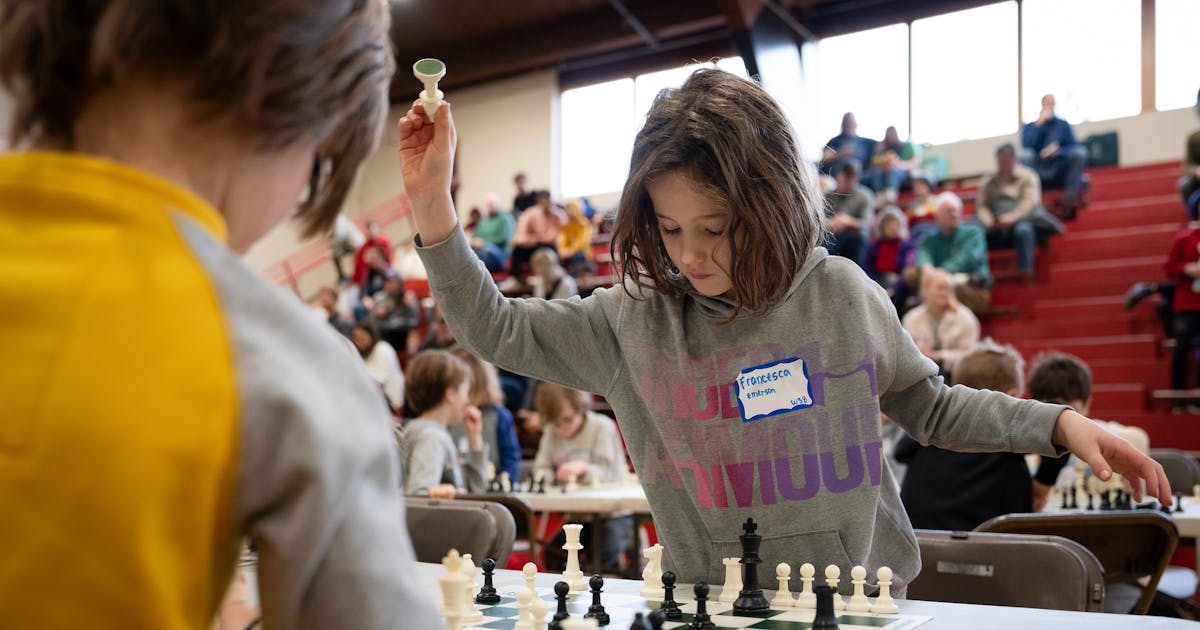Star Tribune
What’s holding Minnesota kids’ attention these days? Chess.

The volunteers tried to shush the students huddled over chess boards recently in a Minneapolis middle school gym. But the enthusiastic chatter of more than 200 young chess players plotting their moves won out — and that was just fine.
“It’s so fun to see them get into it,” said Janae Krantz-Odendahl, a student engagement program coordinator for Minneapolis Public Schools, which put on the free tournament that has seen participation surge. “The interest has just exploded.”
School chess clubs are popping up and growing across Minnesota at all levels, from elementary through college. Students and their club advisers see the boom as one of the more positive and lasting effects of the pandemic, when kids and teenagers turned to online chess games as a way to pass the time. Around the same period, chess content creators like GothamChess grew popular on YouTube and Twitch by finding funny and engaging ways to teach the game’s strategy. The television show “The Queen’s Gambit,” as well as a 2022 headline-making cheating scandal among chess grandmasters, also helped bring renewed attention to chess.
Another boost could soon be coming: three American grandmasters — including a popular chess YouTuber — are set to compete in April for the top spot to play against the reigning world champion from China. If one of them goes on to win, they will be the first American to take the title since Bobby Fischer claimed it in 1972. Young chess players across Minnesota say they’ll be watching.
“There used to be this stigma that chess was just this nerdy thing,” said Dojin Wells, a seventh grader at Anthony Middle School who played at the recent Minneapolis Public Schools tournament. “I wouldn’t necessarily say chess is cool yet, but it’s definitely gotten cooler.”
The Minnesota State Chess Association has seen the number of players at its events double since 2021, and nearly half of its members are scholastic players, meaning they are K-12 students. Association tournaments that typically drew 150 players are now seeing more than 200, said Scott Carpenter, board member for the association.
Bob Dettmer, the chess team adviser at Eastview High School in Apple Valley, hopes those numbers can continue to rise as more young people see how easy and affordable playing chess can be. It doesn’t require expensive coaching, lessons or equipment like so many other activities.
“Honest to goodness, it is accessible to everyone, and you can’t say that about many things,” he said, adding that the game attracts a diverse group of students.
Lured in by strategy
Simon Vergara, a senior biochemistry major at the University of Minnesota Twin Cities, agrees and sees the game as a way to bring people together.
As the founder of a new student club called Chill Chess & Coffee Club, Vergara hopes the trend of playing chess can have staying power. So far, the club has drawn a couple dozen students each week to play casually, and a recent event drew in nearly 30 interested students. Many of them, like him, started playing during the pandemic.
“Before college in 2020, I saw chess as a nerdy, boring game for older people,” he said, adding that he doesn’t remember any of his childhood friends playing chess. “I can now say that I love chess and I don’t feel that stereotype anymore. It’s been a quick change.”
A separate club at the U, called the University of Minnesota Chess Club, has also seen an uptick in interest and said most of the players started playing online in the last couple of years. That club’s president, Samrug Narayanan, said once students realize the game is fun and strategic, it’s a pretty easy sell.
That’s what hooked Seward Montessori fifth-grader Jasper Benson Loesch, who said he enjoys the mental challenge of planning his next move.
“He loves it and it’s done a lot for his concentration,” said his mom, Abby Loesch, while watching him play in the Check it Out tournament. “It’s a really special thing.”
Concentration required
Dettmer, who has coached the Eastview chess team for more than 20 years, calls chess “the antithesis to the iPhone” — though sometimes teachers at the school catch students playing chess on their phones during class. That’s because it forces students to concentrate, to plan ahead and think critically.
“With their phones and TikTok, you see these young people’s attention span being drained away, but you can watch chess build it back up,” he said. “Maybe chess is a fad now but I sure hope it’s a continuing trend.”
Paul Sackaroff, the coach for Osseo Senior High School’s chess club, thinks the game’s popularity will continue to grow.
“I think that the enthusiasm and staying power of chess has already stood the test of time,” he said.
After all, the game is more than 1,500 years old.
And if schools continue to encourage it and make it accessible, he said, “the sky’s the limit.”
Star Tribune
Nicollet Avenue bridge in Minneapolis gets $34 million federal grant
“Under the Biden-Harris Administration, more than 11,000 bridges in communities across America are finally getting the repairs they’ve long needed with funding from our infrastructure law,” said U.S. Transportation Secretary Pete Buttigieg, in a news release. He said the bridge repairs ensure “people and goods can get where they need to go, safely and efficiently.”
Star Tribune
Driver, 19, passing illegally on Wright County road, causes fatal crash
A 19-year-old driver trying to get around slower vehicles collided head-on with an SUV in Wright County and killed one person and injured several others, officials said Thursday.
SUV passenger Janice Evelyn Johnson, 92, of Arden Hills, died Monday at HCMC from injuries she suffered in the collision on Oct. 22 in Monticello Township on County Road 37 near County Road 12, the Sheriff’s Office said in a search warrant affidavit filed in Hennepin County District Court.
The driver and two other people in the SUV survived their injuries, according to the affidavit, which the Sheriff’s Office filed to collect Johnson’s medical records at HCMC as part of its investigation.
According to the affidavit:
Deputies arrived at the crash scene and spoke with the car’s driver, Christian Kabunangu, of Brooklyn Park, who said he was heading west on County Road 37 and found himself behind two vehicles traveling below the speed limit.
“He was late for work, so he decided to pass them,” the affidavit read. Kabunangu said he saw the oncoming SUV and estimated it was about a half-mile down the road.
As he attempted to pass one of the slower vehicles, he explained, the other driver “sped up, preventing him from getting back into the westbound lane,” the filing continued.
As the Honda drew near, he swerved to the left, but the SUV did the same and they collided.
Star Tribune
University of Minnesota researchers find that native plants can beat invasive buckthorn on their own turf.

If the invasive buckthorn that is strangling the life out of Minnesota’s forest floor has a weakness, it is right now, in the shortening daylight of the late fall.
With a little help and planning, certain native plants have the best chance of beating buckthorn back and helping to eradicate it from the woods, according to new research from the University of Minnesota.
The sprawling bush has been one of the most formidable invasive species to take root in Minnesota since it was brought from Europe in the mid-1800s. It was prized as an ornamental privacy hedge. All the attributes that make buckthorn good at that job — dense thick leaves that stay late into the fall, toughness and resilience to damage and pruning, unappealing taste to wildlife and herbivores — have allowed it to thrive in the wild.
It grows fast and thick, out-competing the vast majority of native plants and shrubs for sunlight and then starving them under its shade. It creates damaging feedback loops, providing ideal habitat and calcium-rich food for invasive earthworms, which in turn kill off and uproot native plants. That leaves even less competition for buckthorn to take root, said Mike Schuster, a researcher for the university’s Department of Forest Resources.
When it takes over a natural area, buckthorn creates a “green desert,” Schuster said. “All that’s left is just a perpetual hedge, with little biodiversity.”
Since the 1990s, when the spread became impossible to ignore, Minnesota foresters, park managers and cities have spent millions of dollars a year trying to beat it back. They’ve used chainsaws and trimmers, poisons and herbicides, and even goats for hire. The buckthorn almost always grows back within a few years.
It’s been so pervasive that a conventional wisdom formed that buckthorn seeds could survive dormant in the soil for up to six years. That thought has led to a sort of fatalism: even if the plant were entirely removed from a property there would be a looming threat that it would sprout back, Schuster said.
But there is nothing special about buckthorn seeds. They only survive for a year or two.



